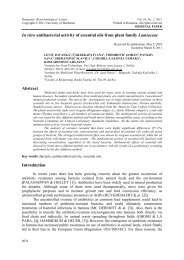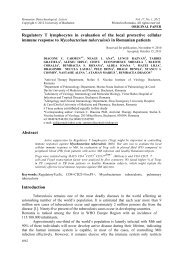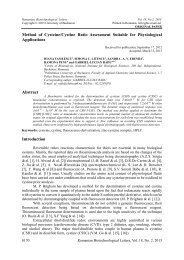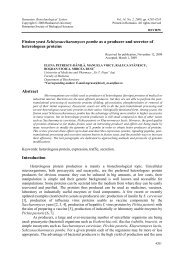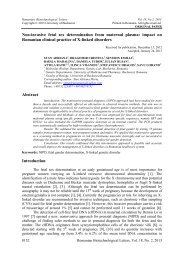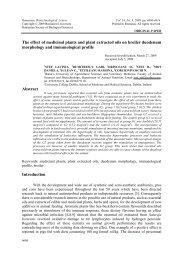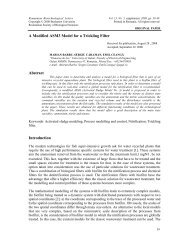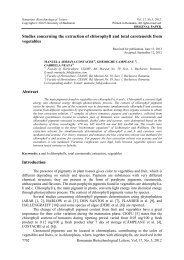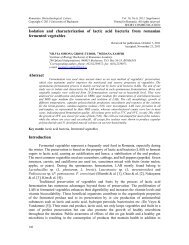Detection and quantification of GMO and sequencing of ... - Rombio.eu
Detection and quantification of GMO and sequencing of ... - Rombio.eu
Detection and quantification of GMO and sequencing of ... - Rombio.eu
You also want an ePaper? Increase the reach of your titles
YUMPU automatically turns print PDFs into web optimized ePapers that Google loves.
Romanian Biotechnological Letters Vol. 14, No. 5, 2009, pp. 4733-4746Copyright © 2009 University <strong>of</strong> BucharestPrinted in Romania. All rights reservedRomanian Society <strong>of</strong> Biological SciencesORIGINAL PAPER<strong>Detection</strong> <strong>and</strong> <strong>quantification</strong> <strong>of</strong> <strong>GMO</strong> <strong>and</strong> <strong>sequencing</strong> <strong>of</strong> the DNA amplifiedproductsReceived for publication, March 20, 2009Accepted, October 5, 2009AbstractMIHAELA ZAULET (1) , LAVINIA RUSU (2) , STELIANA KEVORKIAN (1) , CATALINALUCA (1) , SORINA MIHACEA (3) , ELENA MARCELA BADEA (4) , MARIETACOSTACHE (1)(1) University <strong>of</strong> Bucharest, Molecular Biology Center, 91-95 Splaiul Independentei, 5 th districtBucharest Romania, E-mail: zaulet_mihaela@yahoo.com, tel. 0040213181575, fax0040213181575/ 102(2) Institute <strong>of</strong> Food Bioresources, 6 st Dinu Vintila Street, 2 nd district, Bucharest, Romania(3)Banat' University for Agricultural Sciences <strong>and</strong> Veterinary Medicine, 119 Calea AraduluiTimişoara, Romania(4)Institute <strong>of</strong> Biochemistry, Romanian Academy, 296, Splaiul Independenţei, 6 th districtBucharest, Romania,As a member <strong>of</strong> the European Union since 2007, Romania must comply with the rules forplacing on the market, traceability <strong>and</strong> labeling <strong>of</strong> <strong>GMO</strong>s as laid down in EU legislation. For thisreason, beginning with 2007, Roundup Ready soybean cultivation was banned <strong>and</strong> the only cropapproved for import <strong>and</strong> cultivation in EU, MON810 maize, was grown on about 300ha. In 2009,MON810 hybrids were cultivated on about 3000 ha. The objective <strong>of</strong> this work was to assess, in 2009,the soy derived food products on the Romanian market for compliance with labeling legislation usinga conventional qualitative Polymerase Chain Reaction (PCR) assay to detect the presence <strong>of</strong> GM soy<strong>and</strong> a real-time PCR to quantify the amount <strong>of</strong> RR soy present in positive samples. Additionally, DNAamplified fragments present in RR soybean <strong>and</strong> in MON 810 hybrids were sequenced for assessmentthe nucleotide sequences homology with nucleotide sequences <strong>of</strong> the same fragments existing indatabases. Based on our results, the transgenic Roundup Ready® soybeans are present in a few foodsproducts commercialized in the country. Results <strong>of</strong> real time PCR <strong>quantification</strong> evidenced that onlyfive <strong>of</strong> the fifty quantified samples presented more than 1% <strong>of</strong> GM DNA in its composition. Since theyear 2007, the frequency <strong>of</strong> food <strong>and</strong> feed products containing GM soybean in Romania iscontinuously decreasing. Results <strong>of</strong> the search in the GenBank for nucleodide sequences homologybetween DNA amplified fragments (amplicons) from reference lectin gene <strong>and</strong> for 35S promoter <strong>and</strong>nos terminator <strong>and</strong> nucleotide sequences <strong>of</strong> the same fragments existing in database revealed 100%similarity. For MON810 maize hybrids, the nucleotide sequences homology between the cryIAb <strong>and</strong>invertase gene amplicons <strong>and</strong> nucleotide sequences <strong>of</strong> the same fragments existing in the GanBankwere 97.34% <strong>and</strong>, respectively, 93.8%. Results <strong>of</strong> our analysis revealed point mutations produced atthe level <strong>of</strong> the amplified regions.Keywords: food products, seeds, RR soybean, Bt maize, polymerase chain reaction (PCR),real time PCR, <strong>sequencing</strong>.1. IntroductionRomania adopted its initial legislation on bio-engineered products in 2000. Based onthe new legal framework, the biotech industry was encouraged to enter the Romanian marketwith products already approved elsewhere. Among the first were the applications submittedby Monsanto, for Roundup Ready soybean cultivation. This biotech crop developed to allow4733
MIHAELA ZAULET, LAVINIA RUSU, STELIANA KEVORKIAN, CATALINA LUCA,SORINA MIHACEA, ELENA MARCELA BADEA, MARIETA COSTACHEfor the use <strong>of</strong> glyphosate, the active ingredient <strong>of</strong> the herbicide Roundup, as a weed controlagent, was approved for commercial cultivation at national level.Roundup Ready soybean (event 40-3-2) was approved for marketing in EU. The decisionallowed for the importation <strong>of</strong> seed into EU for industrial processing into non-viable productsincluding animal feeds, food <strong>and</strong> any other products in which soybean fraction are used, only.In Romania, herbicide tolerant soybeans (Roundup Ready, RR) were grown commerciallybeginning with 2000 <strong>and</strong> accounted for 68% (or, in absolute figures, 137 thous<strong>and</strong> hectares)<strong>of</strong> all soybeans planted in 2006 (OTIMAN et al., 2008[1]). In that time, Romania representedone <strong>of</strong> the nine countries in the world that cultivated RR soybean (JAMES et al., 2007[2]).RR soybean cultivation was banned beginning with January 2007 because as Member State,Romania can commercially grow genetically modified plants approved for market release inEU. With no access to the RR technology, the soybean acreage had started to decline in 2007,reaching 133,200 ha, while in 2009 only 68,200 ha were planted with this crop. Romania iscurrently increasingly dependent <strong>of</strong> soybean imports (site <strong>of</strong> Ministry <strong>of</strong> Agriculture accessedat 8 August 2009)MON810 is a genetically modified maize line which is resistant to the European CornBorer. The event was authorized by the United States in 1996 <strong>and</strong> has been approved forimport <strong>and</strong> cultivation in Europe since 1998. In 2008 this maize event was cultivated in sevenEU countries (Spain, Germany, Czech Republic, Portugal, Slovakia, Pol<strong>and</strong>, Romania)(JAMES et al., 2007[2]). As EU Member State, Romania can commercially grow geneticallymodified plants approved for market release in EU. In 2007, MON810 was cultivated onabout 300ha <strong>and</strong> in 2009, on about 3000 ha.In many countries, the labeling <strong>of</strong> grains <strong>and</strong> feed - <strong>and</strong> foodstuffs is m<strong>and</strong>atory if thegenetically modified organism (<strong>GMO</strong>) content exceeds a certain level <strong>of</strong> approved GMvarieties. For instance, the European Union (EU), have set threshold values at 0.9% (EURegulation No. 1830/2003), <strong>of</strong> <strong>GMO</strong> material in a non-GM background as the basis forlabeling. The enforcement <strong>of</strong> these threshold values has created a dem<strong>and</strong> for thedevelopment <strong>of</strong> reliable <strong>GMO</strong> analysis methods <strong>of</strong> a rapid <strong>and</strong> inexpensive character. Most <strong>of</strong>the established analytical methods for detecting the <strong>GMO</strong> identification <strong>and</strong> <strong>quantification</strong> infoods are based on the polymerase chain reaction (PCR), due to its sensitivity, specificity, <strong>and</strong>applicability to the analysis <strong>of</strong> complex food matrices.The objective <strong>of</strong> this work was to determine the compliance with labelling legislation<strong>of</strong> commercially available soybean derived products in Romania using a conventionalqualitative Polymerase Chain Reaction (PCR) assay to detect the presence <strong>of</strong> RR soy <strong>and</strong> areal-time PCR to quantify the amount <strong>of</strong> RR soy present in positive samples. We also verifiedthe stability <strong>of</strong> the nucleotide sequences targeted by pairs <strong>of</strong> primers used for detection <strong>and</strong><strong>quantification</strong> both for RR soybean <strong>and</strong> MON810 events.2. Materials <strong>and</strong> Methods2.1. Samples <strong>and</strong> reference materialSamples <strong>of</strong> the major br<strong>and</strong>s <strong>of</strong> soy-derived food products sold commercially onRomania market were collected. Fifty unlabelled products containing soy such as baby food<strong>and</strong> diet products, soy drinks <strong>and</strong> desserts, t<strong>of</strong>u <strong>and</strong> t<strong>of</strong>u products, soy based meat substitutes(fibber, granule, schnitzel) soy protein, flour as well as yogurt were collected <strong>and</strong> analyzed.All soy-based food products analyzed were made by Romanian companies.4734Rom. Biotechnol. Lett., Vol. 14, No. 5, 4733-4746 (2009)
<strong>Detection</strong> <strong>and</strong> <strong>quantification</strong> <strong>of</strong> <strong>GMO</strong> <strong>and</strong> <strong>sequencing</strong> <strong>of</strong> the DNA amplified productsCertified reference material (CRM), soybean powder containing 0.1 to 5.0% RoundupReady® soybean (IRMM), was used for qualitative <strong>and</strong> quantitative analyses. RR soybeangrains were also used as a control sample. RR soy seeds were kindly provided by theDepartment <strong>of</strong> Phytotechnics from Agricultural University Timişoara.Preparation <strong>of</strong> test samples. To prepare GM mixed test samples, soybeans (GM seeds <strong>and</strong>solid soy-derived products) were separately milled to a fine powder using grinders (Retsch,Haan, Germany).Maize seeds were sampled from a Bt field at harvesting.2.2. DNA extractionDNA extraction <strong>and</strong> purification from raw material <strong>and</strong> from food products <strong>of</strong> plantorigin was carried out using the High Pure <strong>GMO</strong> Sample Preparation Kit (Roche) accordingto the manufacturer’s manual.2.3 Yield <strong>and</strong> quality <strong>of</strong> nucleic acid extractsExtracts were assessed for total DNA yield <strong>and</strong> purity using spectrophotometer.Further, gel electrophoresis was used to assess genomic DNA quality. The presence <strong>of</strong>inhibitors in the PCR reactions was determined by amplifying a portion <strong>of</strong> the soybean lectingene used as an endogenous reference using the plant-specific primer pair <strong>GMO</strong>3/<strong>GMO</strong>4(MEYER et al., 1996[3]; HUBNER, et al., 1999 [4]).For maize MON810, the primers Zein3/Zein4, for zein gene (MATSUOKA et al., 2000 [5]),<strong>and</strong> the primers Ivr1/ Ivr2, for the invertase gene, which encodes acid-soluble is<strong>of</strong>orms, wer<strong>eu</strong>sed (Xu JM at al., 1996 [6]).2.4 Qualitative PCR analysis <strong>of</strong> transgenic sequencesScreening targets commonly used for RR soybean are promoter <strong>and</strong> leader for thecauliflower mosaic virus (CaMV) 35S RNA containing the duplicated enhancer region (p35S)<strong>and</strong> 3' transcript termination sequence <strong>of</strong> the nopaline synthase (nos) coding sequence fromAgrobacterium tumefaciens which terminates transcription <strong>and</strong> directs polyadenylation (tnos). For detection RR soy <strong>GMO</strong> specific primers for P-e35S promoter & T-nos terminatorsequences were used.MON810 maize was detected using the gene- <strong>and</strong> event- specific primers: for cry1Abgene sequence <strong>and</strong>, respectively, for P-e35S promoter (ZIMMERMANN et al., 1998 [7]).Primers were synthesized <strong>and</strong> purified by TibMolBiol <strong>and</strong> the sequences are listed in Table 1.PrimerRoundup ReadyLectin<strong>GMO</strong>3<strong>GMO</strong>435S promoter35S135S2nos-terminatorHA-nos 118-fHA-nos 118-rTable 1. Sequences <strong>of</strong> primers used <strong>and</strong> the size <strong>of</strong> amplicons obtainedSequence(5’−3’)GCCCTCTACTCCACCCCCATCCGCCCATCTGCAAGCCTTTTTGTGGCTCCTACAAATGCCATCAGATAGTGGGATTGTGCGTCAGCATGACGTTATTTATGAGATGGGGACACCGCGCGCGATAATTTATCCTarget or ReferenceGeneSoya lectin geneCaMV (Soyaspecific)NOS terminatorLength <strong>of</strong>AmplifiedFragment118bp195bp118bpMaize MON810ZEIN3AGTGCGACCCATATTCCAGZein maize gene277bpRom. Biotechnol. Lett., Vol. 14, No. 5, 4733-4746 (2009) 4735
MIHAELA ZAULET, LAVINIA RUSU, STELIANA KEVORKIAN, CATALINA LUCA,SORINA MIHACEA, ELENA MARCELA BADEA, MARIETA COSTACHEZEIN4GACATTGTGGCATCATCATTTCRYIA1CRYIA2CRYIA3CRYIA4CGGCCCCGAGTTCACCTTCTGCTGGGGATGATGTTGTTGCCGCACCCTGAGCAGCACGGTGGCACGTTGTTGTTCTGAcryIA(b)Bt-Maize specific189bpIvr1FIvr1RCCGCTGTATCACAAGGGCTGGTACCGGAGCCCGTGTAGAGCATGACGATCIvr-(Maize invertase)226bpVw01Vw03TCGAAGGACGAAGGACTCTAACGTCCATCTTTGGGACCACTGTCGZea Mays (Maize)insect resistant170bpAmplification reactions were performed in a thermocycler model ICycler BIO-RAD, in afinal volume <strong>of</strong> 20 µL 20µl with 5 µl DNA solution. Concetration <strong>of</strong> reagents/ reaction:0.0025 U Ampli GoTaq Polymerase- Promega, 2.5mM MgCl 2 , 0.2mM dNTP mix, buffer 10xfor polymerase <strong>and</strong> 0.5µM <strong>of</strong> each primer (Van DUIJN, G., et al., 2002[8]).Conditions for allthe amplification are given in Table 2.Table 2. PCR conditions used for amplificationPrimers Denaturation Amplification No.<strong>of</strong>Finalextensioncycles35S1/ 35S2HA-nos118- 3 min - 95 0 C 25s -95 0 C; 30s -62 0 C; 45s - 72 0 C 50 7 min - 72 0 Cf/HAnos118-r<strong>GMO</strong>3/<strong>GMO</strong>4 3 min - 95 0 C 30s - 95 0 C; 30s - 63 0 C; 30s - 72 0 C 40 3 min - 72 0 CZEIN3/ZEIN4 3 min - 95 0 C 1min - 96 0 C; 1min - 60 0 C; 3min - 72 0 C 40 3 min - 72 0 CIVR1/IVR2 3 min - 94 0 C 45s - 94 0 C; 45s - 60 0 C; 35s - 72 0 C 45 7 min - 72 0 CVW01/VW03 12 min - 95 0 C 30s - 95 0 C; 30s - 64 0 C; 30s - 72 0 C 40 10 min - 72 0 CcryIA1/cryIA2cryIA3/cryIA43 min - 95 0 C 40s - 95 0 C; 40s - 60 0 C; 40s - 72 0 C 25 3 min - 72 0 CThe amplified products were analyzed by electrophoresis on on a 2.5% agarose gel (100V for60min) containing ethidium bromide in TBE buffer (10mM Tris, 2.75g boric acid/l, 1mM Na 2EDTA).2.5. Real-time PCRReal-time PCR technique allows us to monitor the amplification reaction (in real-time)in a closed environment without interfering with the reaction. Fluorescence signalcorresponding to increased amount <strong>of</strong> amplification product can be measured <strong>and</strong> visualizedon a computer screen. By s<strong>of</strong>tware the signal can be immediately convert into quantitativeestimation. With the fastest available alternative quantitative results can be made availablewithin approximately 30 min from the beginning <strong>of</strong> the first PCR cycle. In comparison,competitive PCR would require at least 3h, usually more.For quantitative PCR we used foodpro<strong>of</strong> <strong>GMO</strong> soy Quantification Kit fromBIOTECON Diagnostics <strong>and</strong> LightCycler 2.0 Real Time equipment.4736Rom. Biotechnol. Lett., Vol. 14, No. 5, 4733-4746 (2009)
<strong>Detection</strong> <strong>and</strong> <strong>quantification</strong> <strong>of</strong> <strong>GMO</strong> <strong>and</strong> <strong>sequencing</strong> <strong>of</strong> the DNA amplified products2.6. SequencingThe products that were positive after conventional PCR analysis were subject to<strong>sequencing</strong>, after purification with Wizard PCR Preps DNA Purification System (Promega).The same primers used for PCR amplification were labelled with BigDye (ABI PRISM ®BigDye TM Terminator Cycle Sequencing Ready Reaction Kit, Applied Biosystems). Theproducts were separated by gel electrophoresis <strong>and</strong> analyzed at ABI PRISM 3130 DNAamplification system (Applied Biosystems). The sequences were aligned with the once fromGenBank using the CLUSTAL W multiple alignment application s<strong>of</strong>tware (BioEDits<strong>of</strong>tware), that was used for designed primers.2.7 Data Collection <strong>and</strong> AnalysisThe percentage <strong>of</strong> GM in different samples was determined by relative <strong>quantification</strong>using st<strong>and</strong>ard curve method plotted Ct (cycle threshold) or delta Ct values as a logarithmfunction <strong>of</strong> the GM percentage or copy numbers.3. Results <strong>and</strong> DiscussionsDNA extraction from soybean food productsThe samples analyzed included a range <strong>of</strong> soybean products, from the very lowprocessed such as the flour, to those highly processed such as t<strong>of</strong>u, soy milk, soy drinks <strong>and</strong>desserts. DNA isolated from all soy products by High Pure <strong>GMO</strong> Sample Preparation Kit(Roche), with slight modifications, was <strong>of</strong> good quality for PCR amplification. Heating <strong>and</strong>fermentation processes does damage DNA template for PCR reaction, but PCR generating thesmaller DNA fragment still can detect the presence <strong>of</strong> DNA (Jeng et al., 2003)The results <strong>of</strong> amplification <strong>of</strong> an endogenous gene for lectin confirms that all samplescontained soybean (Figure 1)1 2 3 4 5 6 7 8 9 10 11 12 13 14 15 MMFigure 1 Agarose gel electrophoresis for lectin PCR products from soy based meat substitutes: 1-10; 10 differentbr<strong>and</strong>s <strong>of</strong> meat substitute products; 11- GM soybean seed; 12 - 5% CRM; 13 - EB (extraction buffer); 14 –EC(environmental control); 15 – NTC (PCR control); 16- Marker PCRRom. Biotechnol. Lett., Vol. 14, No. 5, 4733-4746 (2009) 4737
MIHAELA ZAULET, LAVINIA RUSU, STELIANA KEVORKIAN, CATALINA LUCA,SORINA MIHACEA, ELENA MARCELA BADEA, MARIETA COSTACHE1 2 3 4 5 6 7 8 9 10 11 12 13 14 15 MMFigura 2 Agarose gel electrophoresis <strong>of</strong> the PCR products for lectin gene, from soy based products: 1-2 soymayonnaise; 3-4 soy dessert; 5- 6 soy yogurt; 7- 10 soy beverages; 11-12 – smoky t<strong>of</strong>u; 13- 5% CRM ; 13 -EB(extraction buffer); 14 – Negative control; 15 –. Marker PCRMM 1 2 3 4 5 6 7 8 9 10 11 12 13 14 15 16 17 18 19Figure 3. Agarose gel electrophoresis <strong>of</strong> the PCR products for lectin gene, from soy based products (118 bp). 1-Marker PCR; 2-15 different br<strong>and</strong>s <strong>of</strong> vegetal pate; 16-17 GM soybean seeds; 18 -EB (extraction buffer); 19 –EC (environmental control); 20 - 5% CRM.Qualitative <strong>and</strong> quantitative PCR analysis <strong>of</strong> transgenic sequencesAmplification with primers for the 35S promoter produced the DNA fragment <strong>of</strong> 123 bpconfirming the presence <strong>of</strong> RR soy in some samples, as illustrated in Fig. 3a, (lines 2, 3, 4 <strong>and</strong>6). Additionally, amplification <strong>of</strong> nos terminator produced the DNA fragments <strong>of</strong> 118 bp inthe same samples (Figure 3b, lanes 1, 2, 3, 5 <strong>and</strong> 6).4738Rom. Biotechnol. Lett., Vol. 14, No. 5, 4733-4746 (2009)
<strong>Detection</strong> <strong>and</strong> <strong>quantification</strong> <strong>of</strong> <strong>GMO</strong> <strong>and</strong> <strong>sequencing</strong> <strong>of</strong> the DNA amplified productsFigure 4. a. PCR products obtained for the promoter p35S -123 bp, from soy samples: lane 1- negative control;lane 2 - fibre; lane 3 - granule; lane 4- schnitzel; lane 5- seeds; lane 6- flour; lane 7- granule from anotherproducer; lane 8-MM 50bp; b. PCR products obtained for terminator (tnos) - 118 bp, from soy samples: lane1-fibre; lane 2- granule; lane 3- schnitzel; lane 4- seeds; lane 5- flour; lane 6- granule from another producer; lane7- MM 100bp.The results for the fifty analyzed samples are presented in Table 3. The presence <strong>of</strong> the<strong>GMO</strong> was demonstrated in 5 cases. The positive samples were soy based meat substitutes:fiber (1), granule (1), flour (1), Schnitzel (1) <strong>and</strong> flour (1).Table 3. Results <strong>of</strong> <strong>GMO</strong> analysis <strong>of</strong> different soy - derived food product sold on Romanian marketProductsNumber <strong>of</strong>samplesanalyzedNumber <strong>of</strong>samplespositive forlectin geneNumber <strong>of</strong>sampleswith GMcontent 1%Soy beverages 5 5 5 0Soy milk 10 10 10 0Soy flour 4 4 5 0Vegetal pate 7 7 7 0Feed for chicken 1 1 1 0Texturized soy protein 8 8 8 0Soy desserts 5 5 5 0T<strong>of</strong>u 5 5 5 0Fiber soy 1 1 0 1Soy granule 1 1 0 1Soy flour 2 2 0 2Soy Schnitzel 1 1 0 1Total 50 50 45 5GM positive soy-containing samples were analyzed by RR soy event-specific realtimePCR.The actual calculation is performed by the LightCycler Relative QuantificationS<strong>of</strong>tware, applying the following basic calculation steps: determination <strong>of</strong> the relative ratio <strong>of</strong>Roundup; the amount <strong>of</strong> Roundup Ready soya specific target DNA is expressed as a relativeratio to a soya reference gene, which is normalized to a calibrator.Rom. Biotechnol. Lett., Vol. 14, No. 5, 4733-4746 (2009) 4739
MIHAELA ZAULET, LAVINIA RUSU, STELIANA KEVORKIAN, CATALINA LUCA,SORINA MIHACEA, ELENA MARCELA BADEA, MARIETA COSTACHEThis procedure provides maximum reproducibility <strong>and</strong> controls for factors influencing<strong>quantification</strong>. The calculation <strong>of</strong> the relative <strong>GMO</strong> content is based on the resulting crossingpoints <strong>of</strong> one particular sample, <strong>and</strong> the efficiency <strong>of</strong> the PCR. The amount <strong>of</strong> RoundupReady soya is calculated as a ratio <strong>of</strong> Roundup Ready soya DNA to total soya DNA. The ratio<strong>of</strong> Roundup Ready soya DNA to total soya DNA <strong>of</strong> the sample is divided by the <strong>GMO</strong>:reference ratio <strong>of</strong> the Calibrator DNA which is run in parallel with each sample reaction.This procedure compensates for constant differences between the <strong>GMO</strong> <strong>and</strong> referencegene during detection in the LightCycler Instrument (e.g., Probe annealing, extinctioncoefficients <strong>of</strong> dyes, efficiency <strong>of</strong> FRET process), <strong>and</strong> provides a constant calibration pointbetween PCR runs. The final result is expressed as a ratio <strong>of</strong> <strong>GMO</strong>:reference in the sample,relative to the ratio <strong>of</strong> <strong>GMO</strong>:reference in the Calibrator DNA. The ratio <strong>of</strong> <strong>GMO</strong>: reference inthe foodpro<strong>of</strong> <strong>GMO</strong> Soya Calibrator DNA provided with the kit has a value <strong>of</strong> 1.00Five sample contained RR soy over the 0.9% threshold limit. The results demonstratedthe presence <strong>of</strong> RR soybean in a few processed soy derived products commercially availablein Romania (Figure 5).Figure 5. Real Time PCR <strong>quantification</strong> for Roundup Ready Soybean products.The ratio <strong>of</strong> <strong>GMO</strong>: reference in the foodpro<strong>of</strong> <strong>GMO</strong> Soya Calibrator DNA providedwith the kit has a value <strong>of</strong> 1.00 (Table 4).Table 4. Real –Time PCR <strong>quantification</strong> condition used in our studySample number Sample name NormalizedConcentration ratio% Normalizedconcentration1 Soya Fiber 0.9 902 Soya Granule 0.56 563 Soya Schnitzel 0.19 194 Seeds 1 1005 Soya flour 0.19 194740Rom. Biotechnol. Lett., Vol. 14, No. 5, 4733-4746 (2009)
<strong>Detection</strong> <strong>and</strong> <strong>quantification</strong> <strong>of</strong> <strong>GMO</strong> <strong>and</strong> <strong>sequencing</strong> <strong>of</strong> the DNA amplified productsOur data confirms the conclusion that on Romanian market RR soy containing food<strong>and</strong> feed products is continuously decreasing (LEAU F. et al., 2008 [9]). On the other h<strong>and</strong>,the intensively decreasing rate <strong>of</strong> non-compliance reveals that food producers have followedthe provisions <strong>of</strong> labeling legislation for genetically modified food.Sequences analysis <strong>of</strong> the amplicons derived from RR soy containing food productsThe results <strong>of</strong> the search for nucleotide sequences homology <strong>of</strong> the amplified fragments fromthe five genetically modified soybean samples obtained with primers for lectin gene (Figure6), for t-nos (Figure 7) <strong>and</strong> for p 35S promoter (Figure 8) have revealed 100% homology withthe nucleotide sequences <strong>of</strong> the same genetic elements published in the GenBank. The lectingene is the reference gene while the CaMV35S promoter <strong>and</strong> the t-nos terminator are thetargeted genetic elements. The integrity <strong>of</strong> the nucleotide sequences <strong>of</strong> the soybean DNA insamples <strong>of</strong> raw, partially processed <strong>and</strong> highly processed food may be explained by the smallsize <strong>of</strong> the DNA amplified. However, studies regarding the effect <strong>of</strong> food matrices on thestability <strong>of</strong> DNA, revealed that DNA fragments <strong>of</strong> up to 957 bp in maize products <strong>and</strong> 714 bpin highly processed soy products are still present (BAUER et al., 2003[10]).Figure 6. Alignment with the BioEdit s<strong>of</strong>tware (the CLUSTAL W application) <strong>of</strong> the sequencesfor the lectin gene (five samples). The analysis was carried out by comparison with the genesequences in the GenBank data base.Figure 7. Alignment with the BioEdit s<strong>of</strong>tware (the CLUSTAL W application) <strong>of</strong> the sequencesfor the t-nos terminator region (five samples). The analysis was carried out by comparison with thegene sequences in the GenBank data base.Rom. Biotechnol. Lett., Vol. 14, No. 5, 4733-4746 (2009) 4741
MIHAELA ZAULET, LAVINIA RUSU, STELIANA KEVORKIAN, CATALINA LUCA,SORINA MIHACEA, ELENA MARCELA BADEA, MARIETA COSTACHEFigure 8. Alignment with the BioEdit s<strong>of</strong>tware (the CLUSTAL W application) <strong>of</strong> thesequences for the CaMV35 promoter region (five samples). The analysis was carried out bycomparison with the gene sequences in the GenBank data base.Analysis <strong>of</strong> Maize seeds MON810For maize MON810 the targeted fragments were gene- <strong>and</strong> event specific, cryIAb <strong>and</strong>,respective, the E35S promoter <strong>and</strong> the resulted amplicons were <strong>of</strong> 189 bp <strong>and</strong> 170bp (Figures9,10).Figure 9 a. PCR products obtained for zein gene (277 bp) from maize seeds samples: 1- negativecontrol; 2-7 maize from different hybrids; 8.MM 50bp; b. PCR products obtained for maize invertasegene (226 bp) from maize samples: 1- negative control; 2-7 maize from different hybrids; 8.MM 50bp.4742Rom. Biotechnol. Lett., Vol. 14, No. 5, 4733-4746 (2009)
<strong>Detection</strong> <strong>and</strong> <strong>quantification</strong> <strong>of</strong> <strong>GMO</strong> <strong>and</strong> <strong>sequencing</strong> <strong>of</strong> the DNA amplified productsFigure 10. a. PCR products obtained for the P-E35S gene (170 bp) from maize seeds samples: 1-6 maize seedsfrom different producers; 7.MM 50bp; b. PCR products obtained for the cryaIA(b) gene (189 bp): 1-6 maizeseeds from different producers; 7.MM 50bpThe zein <strong>and</strong> invertase fragments were observed for all maize samples (Figure 9a, 9b).Additionally, all maize samples were positive for the presence <strong>of</strong> MON810 event (Figure 10a,10b)The nucleotide sequences obtained for the E35S amplicon (Figure 11) <strong>and</strong> for the zeingene region (Figure 12) had 100% homology with the sequence published in the GenBank.The nucleotide sequences for the invertase gene (Figure 13) <strong>and</strong> for the cryIAbamplicon (Figure 14) had 93.8% <strong>and</strong>, respectively, 97.34% homology with the sequencespublished in the GenBank.Sequences analysis <strong>of</strong> the amplicons obtained from Maize seeds MON810Figure 11. Alignment with the BioEdit s<strong>of</strong>tware (the CLUSTAL W application) <strong>of</strong> the sequences for thepromoter E35S (six samples). The analysis was carried out by comparison with the gene sequences in theGenBank data base.Rom. Biotechnol. Lett., Vol. 14, No. 5, 4733-4746 (2009) 4743
MIHAELA ZAULET, LAVINIA RUSU, STELIANA KEVORKIAN, CATALINA LUCA,SORINA MIHACEA, ELENA MARCELA BADEA, MARIETA COSTACHEFigure 12. Alignment with the BioEdit s<strong>of</strong>tware (the CLUSTAL W application) <strong>of</strong> thesequences for the zein gene (six samples). The analysis was carried out by comparison with thegene sequences in the GenBank data base.Figure 13. Alignment with the BioEdit s<strong>of</strong>tware (the CLUSTAL W application) <strong>of</strong> the sequencesfor the invertase gene (six samples). The analysis was carried out by comparison with the genesequences in the GenBank data base.Observation: Heterozygous plants are presented as having nucleotides marked with N. This mayrefer to any <strong>of</strong> the nucleotide types located at the level <strong>of</strong> that particular site. In the alignment, theN nucleotide in the 150, 151 <strong>and</strong> 170 positions may be either C or G.4744Rom. Biotechnol. Lett., Vol. 14, No. 5, 4733-4746 (2009)
<strong>Detection</strong> <strong>and</strong> <strong>quantification</strong> <strong>of</strong> <strong>GMO</strong> <strong>and</strong> <strong>sequencing</strong> <strong>of</strong> the DNA amplified productsFigure 14. Alignment with the BioEdit s<strong>of</strong>tware (the CLUSTAL W application) <strong>of</strong> the sequencesfor the cryIA(b) gene (six samples). The analysis was carried out by comparison with the genesequences in the GenBank data base.Results <strong>of</strong> our analysis revealed point mutations produced at the level <strong>of</strong> the regionsamplified. There are several conflicting reports on transgene stability in MON810 maize.HERNANDEZ et al. [11], (2003) <strong>and</strong> CHANDRA et al., (2007) [12] evidenced a truncationevent MON810 at the 3’ end <strong>of</strong> the cryI(A)b gene with the complete loss <strong>of</strong> the NOSterminator. The authors recommend use <strong>of</strong> the sensitive detection <strong>and</strong> <strong>quantification</strong> tests thatwould enable monitoring <strong>of</strong> transgene stability over successive generations <strong>and</strong> wouldprovide information on the effect <strong>of</strong> the genomic background on the DNA insert stability.Single nucleotide polymorphism (SNPs) occurs in the plant genome as a results <strong>of</strong>plant- environmental interactions <strong>and</strong> are part <strong>of</strong> the normal life cycle <strong>of</strong> the plant(MADLUNG&COMAI, 2004[13]). The effect <strong>of</strong> a minor modification such as a single basepair mismatch in the primer attachment site on the real time PCR amplification <strong>and</strong> <strong>GMO</strong><strong>quantification</strong> was studied (GHEDIRA et al., 2008[14]). The presence <strong>of</strong> a single base pairmismatch between the primer <strong>and</strong> DNA template resulted in a statistically significant shift <strong>of</strong>the Ct value.During transgene inheritance, deletion, duplication, rearrangement <strong>and</strong> repeatedsequence recombination for transgenic loci have been reported (YIN et al., 2004[15]).However, the functional stability <strong>of</strong> the truncated MON810 transgene, was confirmed bydetection <strong>of</strong> Cry1Ab protein by a ELISA assay (data not shown).References1. OTIMAN IP, Elena Marcela Badea EM, L Buzdugan L.2008. Roundup Ready Soybean, a Romanian story.Bulletin USAMV-CN, 65 (1-2), 352-357.2. JAMES C. Global status <strong>of</strong> commercialized transgenics crops: 2007. ISAAA Briefs Nº 37. Ithaca, NY:International Services for the Acquisition <strong>of</strong> Agri-Biotech Applications,3 MEYER, R. Development <strong>and</strong> application <strong>of</strong> DNA analytical methods for the detection <strong>of</strong> <strong>GMO</strong>s in food.Food Control, 10, 391–399.4. HUBNER P, Studer, E., Hafliger, D., Stadler, M., Wolf, C., & Looser, C. (1999). <strong>Detection</strong> <strong>of</strong> geneticallymodified organisms in food: critical points for quality assurance. Accreditation <strong>and</strong> Quality Assurance, 4,292–298).Rom. Biotechnol. Lett., Vol. 14, No. 5, 4733-4746 (2009) 4745
MIHAELA ZAULET, LAVINIA RUSU, STELIANA KEVORKIAN, CATALINA LUCA,SORINA MIHACEA, ELENA MARCELA BADEA, MARIETA COSTACHE5. MATSUOKA T., Kawashima, Y., Akiyama, H., Miura, H., Goda, Y., Kusakabe, Y., et al. (2000). A method<strong>of</strong> detecting recombinant DNAs from four lines <strong>of</strong> genetically modified maize. Journal <strong>of</strong> Food HygienicSociety <strong>of</strong> Japan, 41, 137–143.6. Xu JM, Avigne WT, McCarty DR, Koch KE (1996): A similar dichotomy <strong>of</strong> sugar modulation <strong>and</strong>developmental expression affects both paths <strong>of</strong> sucrose metabolism: evidence from a maize invertase genefamily. Plant Cell 8: 1209–12207. ZIMMERMANN A., Hemmer, W., Liniger, M., Luthy, J., & Pauli, U.(1998). A sensitive detection methodfor genetically modified MaisGardTM corn using a nested PCR-system.-Technologie, 31, 664–667.8. Van DUIJN, G., Van Biert, R., Bleeker-Marcelis, H., Van Boeijen, I., Adan, A. J., Jhakrie, S., et al. (2002).<strong>Detection</strong> <strong>of</strong> genetically modified organisms in foods by protein-<strong>and</strong> DNA-based techniques: bridging themethods. Journal <strong>of</strong> AOAC International, 85(3), 787–7919. LEAU F. H. Coste, M. Bosneag, G. Diaconu, I. Zybaczynski <strong>and</strong> I. Olaru PCR testing <strong>of</strong> RR Soy in food<strong>and</strong> feed in Romania 1st Global Conference on <strong>GMO</strong> Analysis, Villa Erba, Como, Italy 24-27 June 2008,97-9810. BAUER T., Weller, P., Hammes, w.p., Herter, C., 2003, The effect <strong>of</strong> processing parameters on DNAdegradation in food. European Food Research <strong>and</strong> Technology 217, 338-343.11. HERNANDEZ M., Pla, M., Esteve, T., Prat, S., Puigdomènech, P., Ferr<strong>and</strong>o, A. (2003).A specific real-timequantitative PCR detection system for event MON810 in maize YieldGard® based on the 3’-transgeneintegration sequence. Transgenic Res. 12, 179–18912. CHANDRA K. Singh, Abhishek Ojha, Suchitra Kamle <strong>and</strong> Devendra N. Kachru. Assessment <strong>of</strong> cry1Abtransgene cassette in commercial Bt corn MON810: Gene, Event, Construct & <strong>GMO</strong> specific concurrentcharacterization Nature Protocols DOI: 10.1038/nprot.2007.44013. MADLUNG, A., COMAI, L., 2004 The effect <strong>of</strong> stress on genome regulation <strong>and</strong> structure. Annals <strong>of</strong>Botany 94, 481-485.14. GHEDIRA R. Papazova N, de Loose M, Taverniers I. Influence <strong>of</strong> point mutations on real-time PCRefficiency: relevance for <strong>GMO</strong> <strong>quantification</strong>. gmoglobalconference.jrc.ec.<strong>eu</strong>ropa.<strong>eu</strong>/Posters.htm Lastupdate: 14/08/200815. YIN Z., Plader, W., Malepszy, S. 2004; Transgene inheritance in plants. J. Appl. Genet. 45, 127-144,4746Rom. Biotechnol. Lett., Vol. 14, No. 5, 4733-4746 (2009)



